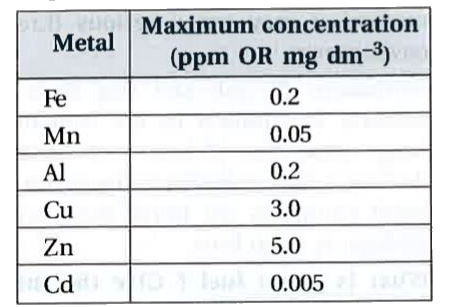Give a brief explanation about about the international standards of drinking water.
Text Solution
The international standards for drinking water are given below:
(i) Fluoride : Fluoride ion concentration should be tested in drinking water. Its deficiency in drinking water is harmful to man and causes diseases such as tooth decay etc. Soluble fluoride is often added to drinking water to bring its concentration upto 1 ppm or 1 mg dm−3 .
The F− ions make the enamel on teeth much harder by converting hydroxyapatite, [3(Ca3PO4)2Ca(OH)2], the enamel on the surface of the teeth, into much harder fluorapatite [3(Ca3PO4)2.CaF2].
If F− ion concentration above 2 ppm causes brown mottling of teeth. Whereas if F− ion concentration is more than 10 ppm it causes harmful effect to bones and teeth. It is reported from some parts of Rajasthan.
(ii) Lead : Drinking water gets contaminated with lead when lead pipes are used for transportation of water. The prescribed upper limit concentration of lead is about 50 ppb lead can damage kidney, liver, reproductive system etc.
(iii) Sulphate : Excessive sulphate (> 500 ppm) in drinking water causes laxative effect, otherwise at moderate levels it is harmless.
(iv) Nitrate : The maximum limit of nitrate in drinking water is 50 ppm. Excess nitrate in drinking water can cause disease like methemoglobinemia (blue baby. syndrome).
(v)Other metals : The maximum concentration of some common metals recommended in drinking water. Which are given in table.

|
Topper's Solved these Questions
- ENVIRONMENT CHEMISTRY Book:KUMAR PRAKASHANChapter:ENVIRONMENT CHEMISTRY Exercise:SECTION-B (Objective Questions) (Short Questions)
Explore 40 Videos
- ENVIRONMENT CHEMISTRY Book:KUMAR PRAKASHANChapter:ENVIRONMENT CHEMISTRY Exercise:SECTION-B (Objective Questions) (Fill in the Blanks)
Explore 20 Videos
- CLASSIFICATION OF ELEMENTS AND PERIODICITY IN PROPERTIES Book:KUMAR PRAKASHANChapter:CLASSIFICATION OF ELEMENTS AND PERIODICITY IN PROPERTIES Exercise:Section -D SOLUTIONS OF NCERT EXEMPLAR PROBLEMS (Long Answer Type Questions )
Explore 7 Videos
- EQUILIBRIUMBook:KUMAR PRAKASHANChapter:EQUILIBRIUMExercise:Question Paper from Module
Explore 7 Videos
Similar Questions
Knowledge Check
Consider the following statement about different impurities in drinking water.
AOnly III is correctBAll but I are correctCAll but II are correctDI,II and III are correctThe prescibed upper limit concentration of lead in drinking water is about :
A30 ppbB70 ppbC50 ppbD90 ppbDrinking water gets contaminated with lead when lead pipes are used for transportation of water. The prescribed upper limit concentration of lead in drinking water is about ?
A50 ppmB5 ppmC0.5 ppmD0.05 ppm
According to international standards of drinking water, the tolerable limit for fluoride ions in water is ______
View SolutionGive brief details about following:
Cotton textile industry
View SolutionGive a brief description about the woodcutter community of Java - the Kalangs.
View SolutionWrite in brief about the Blood transfusion
View SolutionThe prescibed upper limit concentration of lead in drinking water is about :
View Solution

